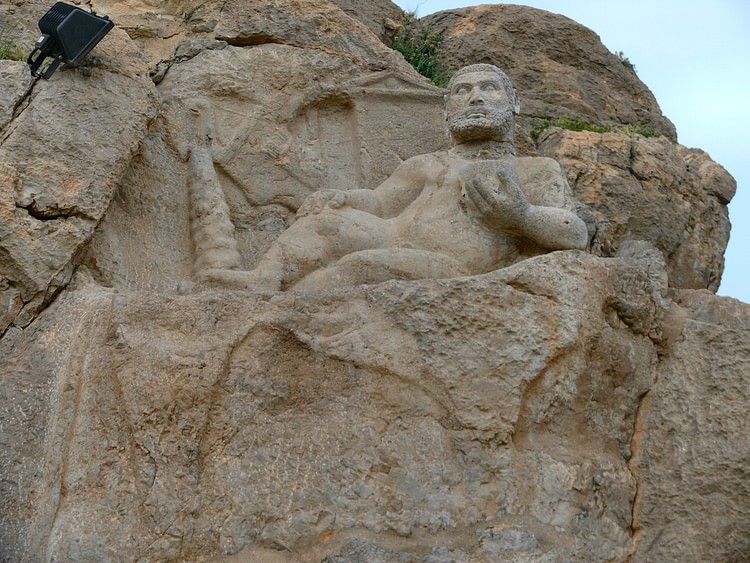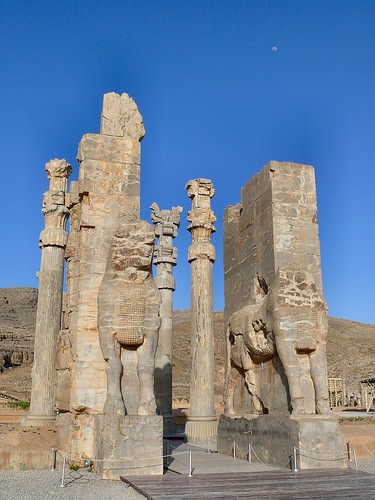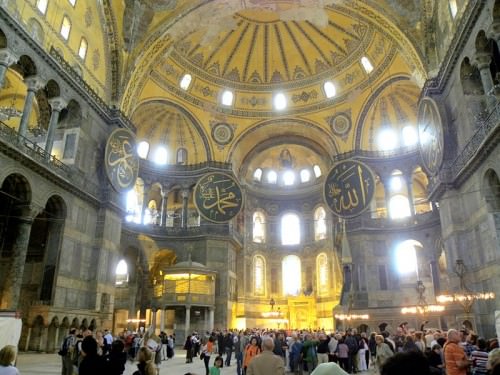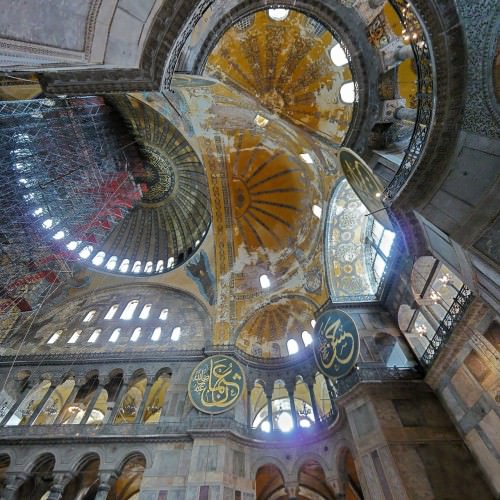Persis › Hagia Sophia » Ancient origins
Articles and Definitions › Contents
- Persis › Ancient History
- Hagia Sophia › Antique Origins
Ancient civilizations › Historical and archaeological sites
Persis › Ancient History
Definition and Origins

Persis (in Greek, derivated from Persian pars ) is the ancient name of the approximate area of modern Fars in Central Iran, as well as a state of the Hellenistic and Imperial periods in this same province. Its name is derived from the Persians who settled in the area in the 7th century BCE, the place being called Anšan before.
PROVINCE OF PERSIS
Persis was the Persian homeland, a land of river basins and plateaus which stretched forth from the Zagros Mountains. Its heart roughly corresponded to modern Fars, consisting of river-drained plains between two ridges of the Zagros Mountains, running horizontal from east to west. This land, composed of basins and valleys, was fertile; agriculture being sustained by a complex web of irrigation ditches.
The north-western plains were characterized by more hills and valleys at a higher altitude and so received more rain than their south-eastern counterpart. In the higher altitudes, temperate forests could be found, including oaks, date palms, and pomegranates.
Here lay Pasargade, the early capital of the Persian Kings of Kings, as well as the equally famous city of Persepolis. Nearer the salt lakes in the north lay Anšan, the ancient seat of Persian power and original home of Cyrus the Great, founder of the Persian Empire. The Mand River separated Anšan from other cities in the east.

All Nations Gate at Persepolis
KINGDOM OF PERSIS
Persis is also the name given today to a small kingdom of the eponymous area which lasted roughly from 300 BCE to 211/212 CE.
The history of the Kingdom of Persis is surrounded by shadows and contradictory hypotheses but, according to the most recent analysis, this state appeared under Seleucos I 's reign (305-281 BCE), when Persis and the whole Middle East were under Seleucid control. Seleucos seems to have formed an alliance with a local Persian dynasty, which gained substantial power in Persis. Persis rulers took the title of frataraka, “keeper of the fire,” equivalent to a sub-satrap title. Their power in Persis was completed by the presence of a Seleucid satrap of Persis, leading to a relationship of coexistence but the precise details of this situation are not fully understood in the modern day.
The four first rulers were Artaxares I (Persian Ardaxshir), Oborzes (Persian Wahabarz), Autophradates I (Persian Vadfradad), and Bagadates (Persian Bagdan). They kept the frataraka title and minted coins, probably keeping good relations with the Seleucids. The exception is the reign of Oborzes (c. 270 - 240 BCE?), who killed 3000 Greek colonists according to Polyaeneus (7.40). Further evidence of turbulent reigns can be found in coin overstrikes, showing that the rulers Autophradates I and Bagadates were not on good terms with each other.
When the Seleucid Antiochos III came to power, he put Alexander, a Greek, at the head of the Persis satrapy, alongside Alexander's brother Molon in Media. Despising the king on account of his youth, Alexander helped his brother Molon to revolt against Antiochos III in 222-220 BCE, along with the Upper Satrapies ( Polybius V.40.6 - V.53.12). Defeated, Molon and Alexander killed themselves (Polybius V.53.9), then Antiochos III sent Tychon, the chief secretary of his army, to “take the command of the Persian gulf province”.
Following this revolt, which should have involved the frataraka, the Persis dynasty disappeared from sight until Autophradates II (Persian Vadfradad). From this ruler until the last one, kings all bear the title ( malakh ) instead of frataraka.
Persis kings seemed to be loyal to the Seleucids until their defeat by the rising Parthians in 141 BCE. The Parthians then kept them as vassals, as they did later with several little kingdoms in Mesopotamia. One of the kings of Persis, Ardashir, greatson of Sassan, revolted against Parthian King Artabanos VI in 211/2 AD and, crushing him, founded the Sassanian empire, virtually ending the kingdom of Persis by merging it with the former Parthian Empire under his rule.
Very little is known of the cultural aspects of the kingdom of Persis. They ruled from Estakhr, where Achaemenid tombs are located. The dynasty shows several indications of Hellenization on their coins and on the scarce representation they left us, alongside reminiscent pictures from Achaemenid art.
Administration aspects were probably similar to those used by the early Sassanids, with a king giving orders to several kyrios(Lords). Ultimately, the legacy of the kingdom of Persis became visible through Sassanid cultural elements even though many important aspects remain unknown.
Hagia Sophia › Antique Origins
Definition and Origins

Hagia Sophia in Istanbul, constructed 532-537 CE, continues to be revered as one of the most important structures in the world. Hagia Sophia ( Greek Ἁγία Σοφία, for 'Holy Wisdom') was designed to be the major basilica of the Byzantine Empireand held the record for the largest dome in the world until the Duomo was built in Florence in the 15th century CE. Additionally, Hagia Sophia became more important with time as subsequent architects became inspired by the dome when building later churches and mosques.
CONSTRUCTION & DESIGN
After the Nike Riots of 532 CE destroyed the previous basilica in Constantinople, Emperor Justinian sought to create the greatest basilica in the Roman Empire. He charged two architects, Anthemios of Tralles and Isidore of Miletus to create a structure worthy of the capital of the Roman Empire. The architects, who were primarily mathematicians, made use of new architectural concepts in order to build exactly what the emperor wanted. In order to create the largest interior space possible, they designed an enormous dome and supported it using a revolutionary construction method called pendentives. Hagia Sophia makes use of four triangular pendentives which allow for the weight of the circular dome to transition to a square supporting superstructure below without massive pillars or columns interrupting the internal space.
THE ENORMOUS DOME IS SUPPORTED USING A REVOLUTIONARY CONSTRUCTION METHOD.
The dimensions of the extant structure show Hagia Sophia's near square shape: length 269 feet (81 m), width 240 feet (73 m).The cupola of the current dome hovers 180 feet (55 m) above the mosaic floor. The structure and first dome, which partially collapsed in 557 CE, were first completed in 537 CE. The second dome, designed with structural ribs and a greater arc than the previous dome, was designed by the nephew of one of the original architects, Isidore the Younger.
Isidore the Younger was faced with fixing several issues that had caused the original dome to collapse. First, during the original construction, the bricklayers had heedlessly applied more mortar than brick. Additionally, in the rush to complete the original dome, they had not waited for a layer of mortar to set before applying the next level of bricks. This caused structural problems that were only exacerbated by a dome which was too shallow. When a dome's arc is round enough the weight and force of the structure descends down into the supporting piers. However, the original dome's arc was too shallow, thereby, pushing outward and forcing the already weakened walls to give. To fix these problems Isidore the Younger increased the height of the dome, which increased the arc and depth, and added 40 ribs to provide support. Before these improvements, however, he was forced to rebuild much of the original walls and semi-domes in order to make the new dome last longer than the first.
DESCRIPTONS OF THE DOME
This history of the two generations of architects and two separate domes are known through both Byzantine authors and through 20th century CE architectural surveys. The magnificence of Hagia Sophia is recorded throughout the centuries as shown in this description by a 9th century CE patriarch of Constantinople named Photios:
It is as if one were stepping into heaven itself with no one standing in the way at any point; one is illuminated and struck by the various beauties that shine forth like stars all around. Then everything else seems to be in ecstasy and the church itself seems to whirl around.
In the 20th century CE, many architectural engineers were fascinated by the scale of Hagia Sophia and wanted to know how it was designed, executed, and built. Robert Van Nice, working for Dumbarton Oaks, was the first Westerner given access to the newly secularized Hagia Sophia in the 1930s CE. Van Nice's structural analysis was subsequently published in the 1960s CE.

Hagia Sophia, Istanbul
The aesthetic qualities of a geometric design are what most concern the twentieth century work on Hagia Sophia. Due to the association of beauty, harmony, and mathematics, an objective description of Hagia Sophia reveals a certain beauty concerning its design. This is true of many structures built in Ancient Rome and Late Antique Constantinople, for example. As Anthony Cutler wrote in the 1950s CE, “the essential and manifest characteristic of early Byzantine architecture, the disciplinary relationship between mathematics and structural mechanics.” For example, the design of Hagia Sophia makes use of pendentives as an aesthetic choice that creates harmony and symmetry. According to Cutler, the pendentive is a geometric solution to an engineering problem that simultaneously creates an aesthetic affect. This interplay of geometry and beauty characterizes Byzantine understanding and engineering genius. The dome's design symbolizes something immense and beautiful.
INTERIOR DECORATION
The interior of Hagia Sophia was innovative in its decoration as well. The interior is lined with enormous marble slabs which may have been chosen and designed to imitate moving water. The central dome is floated on a ring of windows and supported by two semi-domes and two arched openings. This creates an enormous uninterrupted nave. The pendentives were covered with enormous mosaics of six winged angels called hexapterygon. The two arched openings are supported by massive porphyry columns which descend all the way to the floor. Originally the nave was lined with intricate Byzantine mosaics which portrayed scenes and people from the Gospels. After the Ottoman Conquest, many of these mosaics were covered over with Islamic calligraphy and only rediscovered in the 20th century CE after the secularization of Turkey (Hagia Sophia became a museum in 1935 CE). This includes the mosaic on the main dome which was probably a Christ Pantocrator (All-Powerful) which spanned the whole ceiling and is now covered by remarkable gold calligraphy. On the floor of the nave there is the Omphalion (navel of the earth), a large circular marble slab which is where the Roman and Byzantine Emperors were coronated. One of the final additions the Ottoman Sultans made to finalize the transition from Christian basilica to Islamic mosque was the inclusion of eight massive medallions hung on columns in the nave which have Arabic calligraphy inscribed upon them with the names of Allah, the Prophet, the first four Caliphs, and the Prophet's two grandsons. The Ottomans also added a mihrab, a minbar, and four enormous minarets in order to complete the transition to a mosque.

Hagia Sophia Interior
INFLUENCE ON LATER ARCHITECTS
The daring genius of the architects made use of pendentives and tympana on a scale not previously envisioned. Their use of innovative techniques include a brick aggregate that is lighter and more plastic than solid stone or concrete which allowed for the dome to create an internal space not surpassed in Western Europe for 1,000 years. Additionally, after the fall of Constantinople in 1453 CE, the genius of Hagia Sophia's architects continued to dominate the conquering Ottomans who made use of the designs for their mosques. The Ottomans conquered the city, but the artistic culture of the Byzantines, in a way, conquered the Ottomans. Hagia Sophia, under orders from Mehmed the Conqueror, was converted into a mosque within days of the conquest preserving the Byzantine architectural legacy in a new form and era.
The most famous Ottoman architect, Sinan, was directly influenced by Hagia Sophia and other Byzantine structures. Working in the time of Suleyman the Magnificent, Sinan designed numerous imperial mosques and other structures with the same hemispherical dome-supported pendentives upon parallel semi-domes and walls. A layout and design certainly inspired by Hagia Sophia. Hammond suggests Sinan's greatest work, the Suleymaniye Mosque completed in 1557 CE, maintains a continuity with Hagia Sophia while simultaneously synthesizing it with the then contemporary Renaissance architectural innovations occurring in Italy.
Later Ottoman mosques were equally influenced by Hagia Sophia. The Blue Mosque, for example, preserves a layout inspired by Hagia Sophia that builds upon its innovations of pendentives and semi-domes to create internal space. Additionally, Islam's use of geometric shapes and patterns, as opposed to Orthodox's use of icons, also finds continuity in Greco-Roman-Byzantine's use of geometry in sacred architecture as mentioned previously. In fact, the very same Sinan who built the Suleymaniye also worked to repair the millennium-old Hagia Sophia during the reign of Selim II.
In addition to the impact Hagia Sophia has had on Ottoman architecture, it also inspired and influenced Greek and Russian Orthodox architecture for centuries. Victoria Hammond, author of Visions of Heaven: The Dome in European Architecture, in particular, suggests that Russian Orthodox basilicas in Moscow and Kiev were directly inspired by early Muscovite contact with Constantinople in the 10th century CE.
Despite the finality of the transition from Byzantine to Ottoman with the removal of the Christian icons Hagia Sophia continued in its function as a sacred space as a mosque called Ayasofya. Even today Hagia Sophia maintains its position as a sacred space, despite its current position as a secular museum, because of what it inspires, what it symbolizes, and the effects it creates on visitors. The original architects' vision of a structure as the synthesis of religion and mathematics determines the impact it has on the viewer. And in return, it is the impact that Hagia Sophia has on the eye which determines its lasting importance and beauty. It's scale, symbolism, and transcendence of the construction material demonstrate what Justinian said when it was first completed in 537 CE, “O, Solomon, I have outdone thee!”
LICENSE:
Article based on information obtained from these sources:with permission from the Website Ancient History Encyclopedia
Content is available under License Creative Commons: Attribution-NonCommercial-ShareAlike 3.0 Unported. CC-BY-NC-SA License